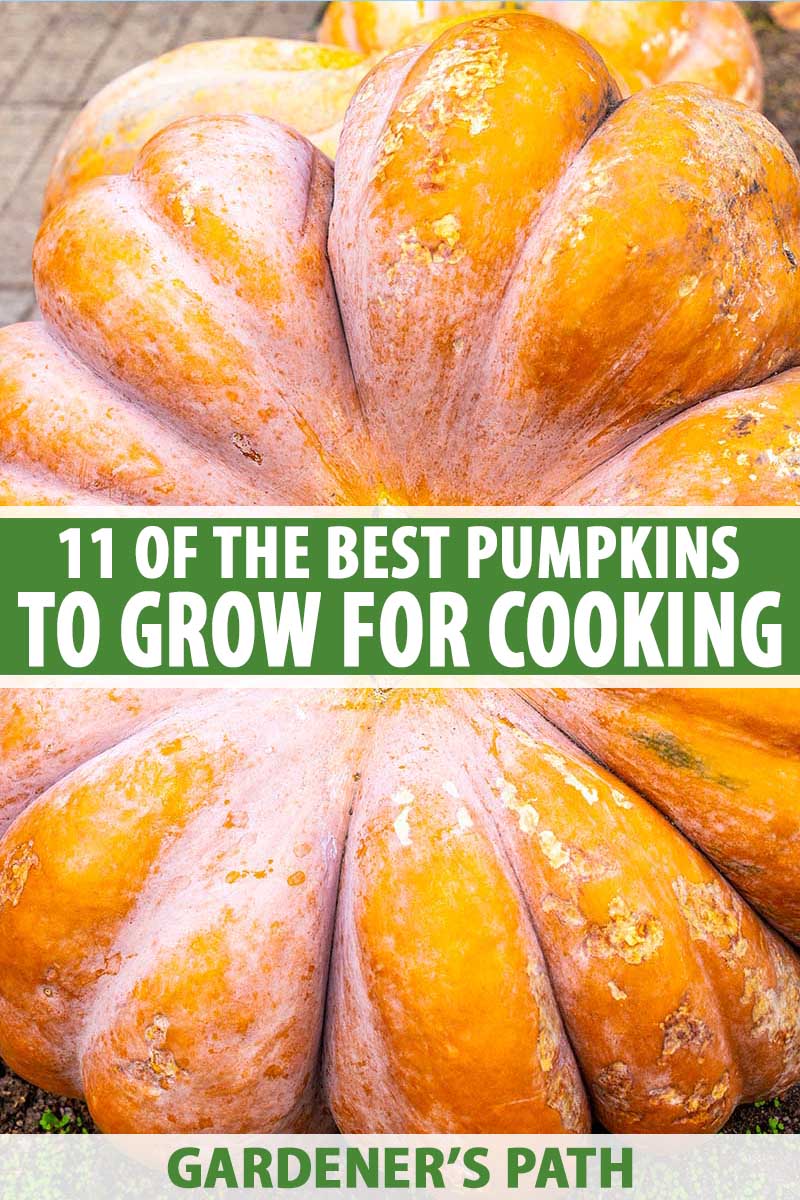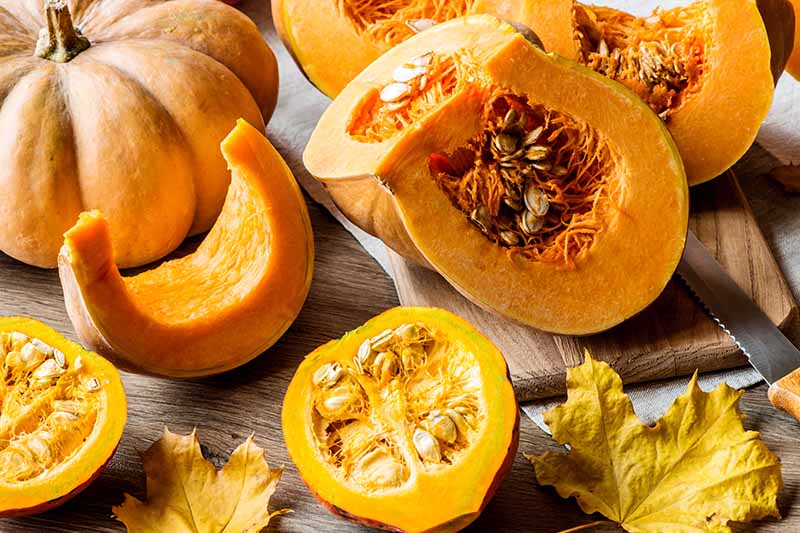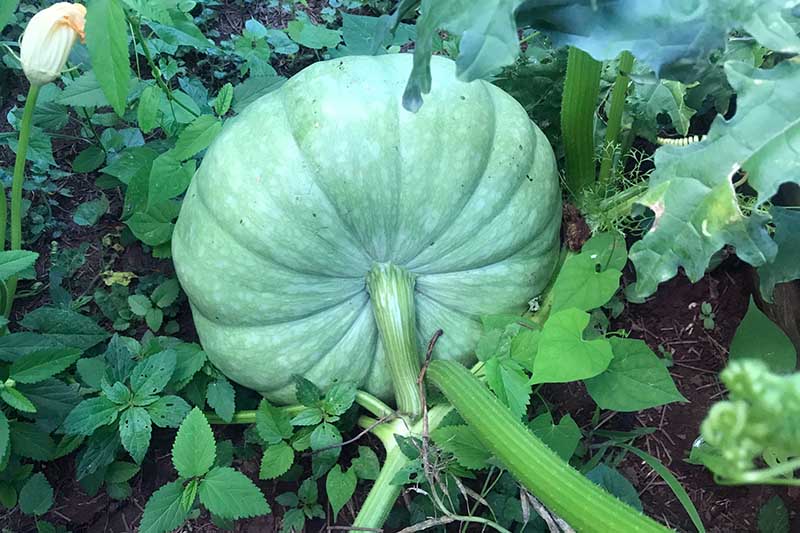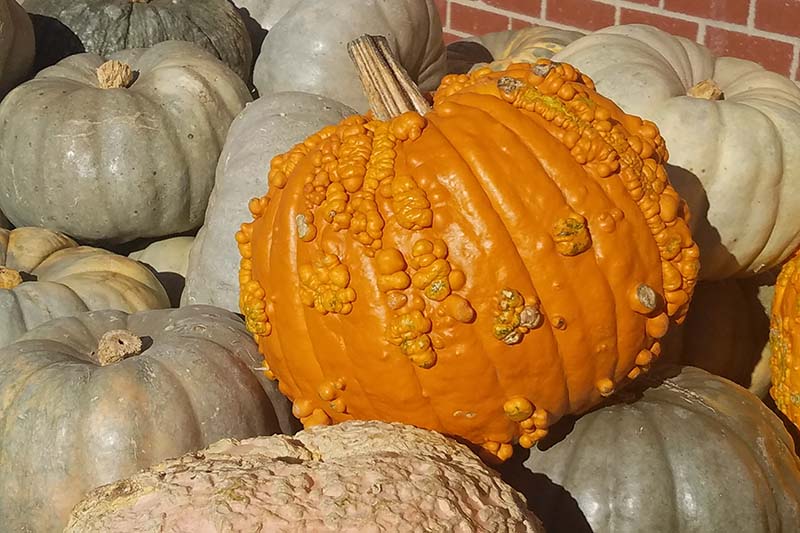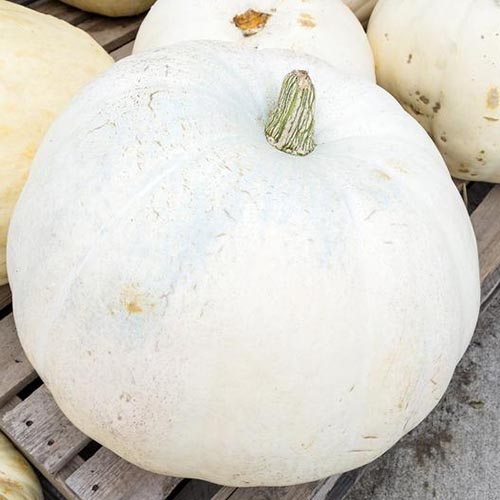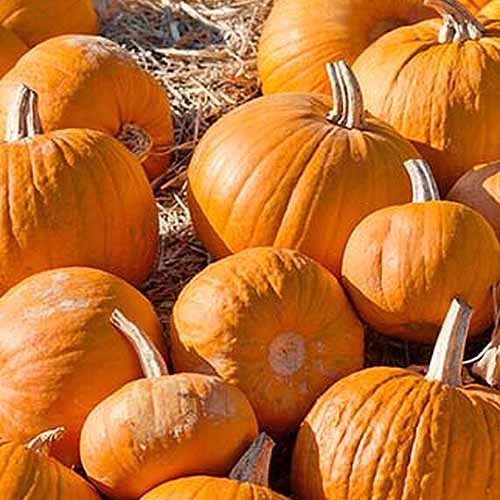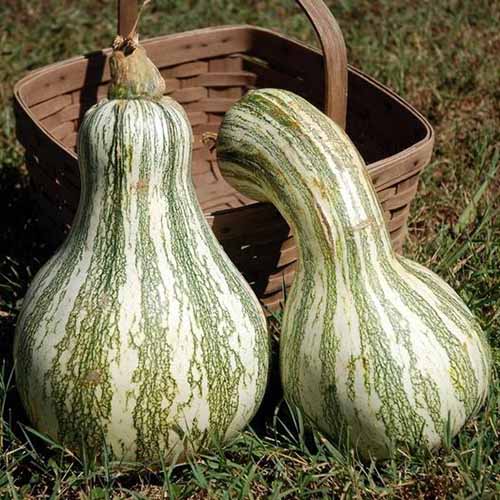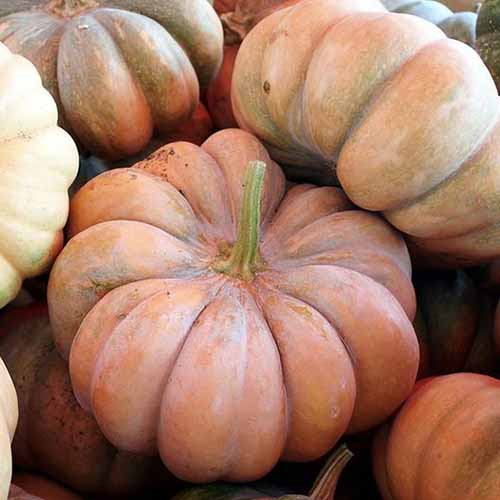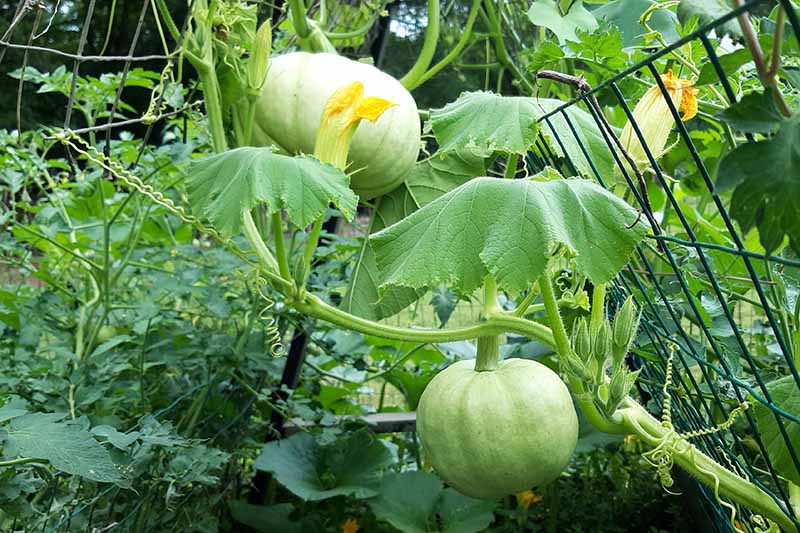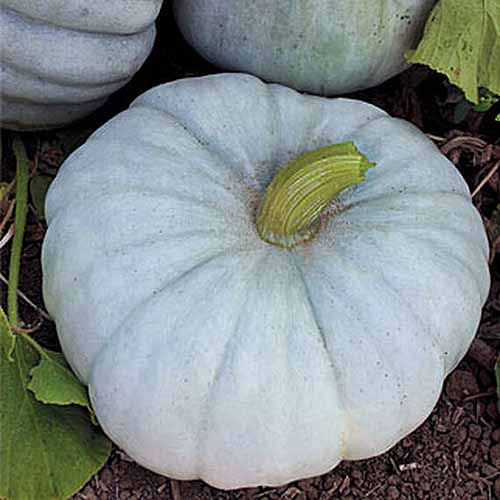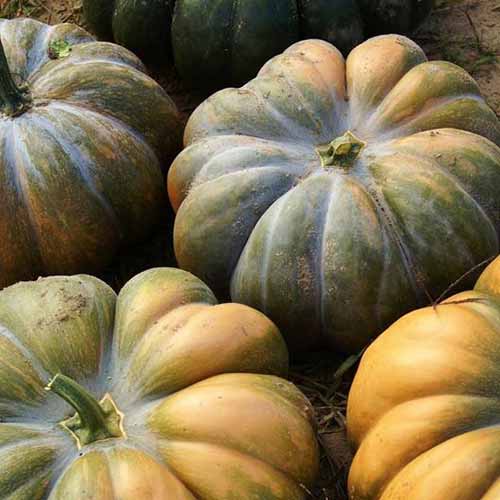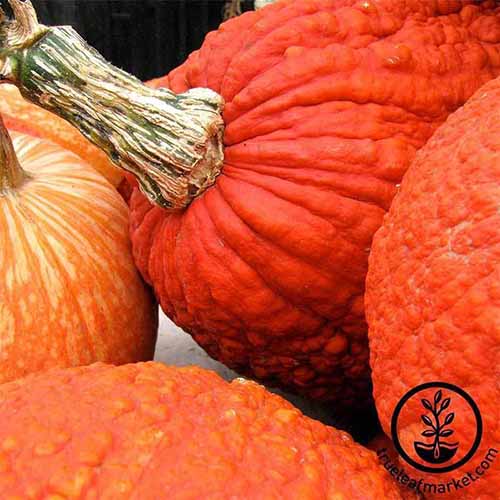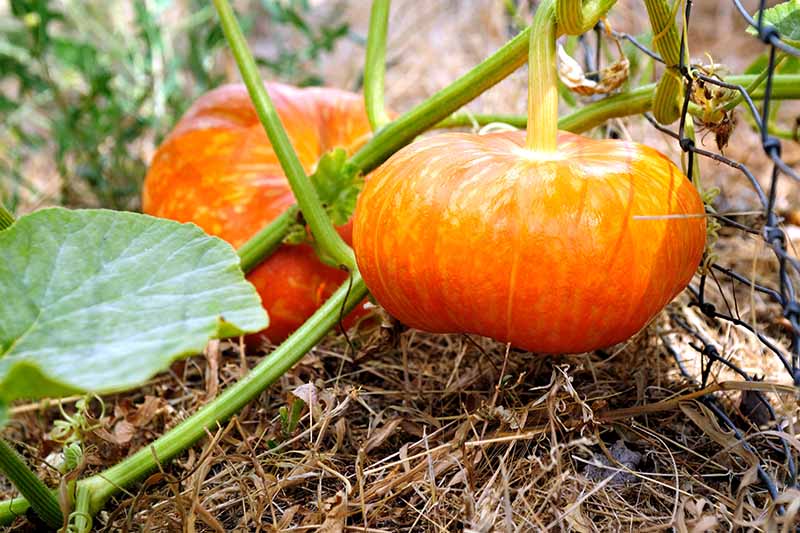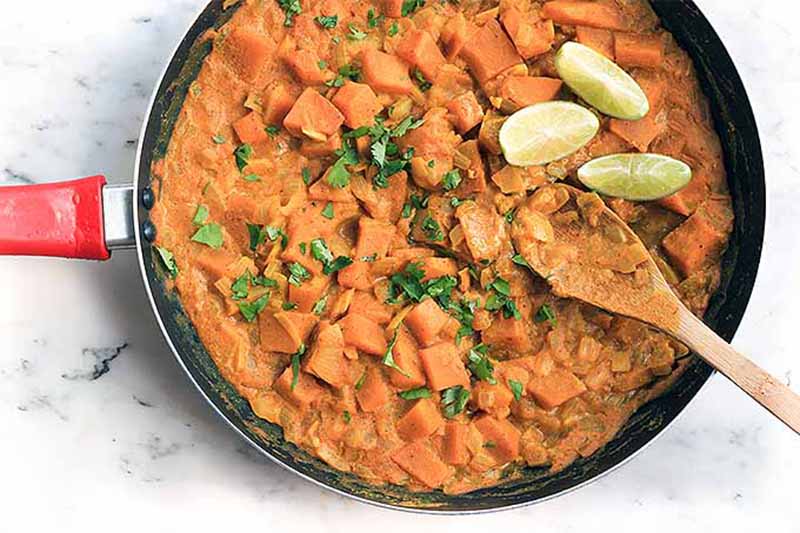But along with folksy celebrations and fairy tales, pumpkins can help you to be more imaginative in the kitchen. While most are familiar with pie pumpkins, there are many other delicious ways to enjoy these members of the Cucurbitaceae family. Muffins, pancakes, soups, stews, and even pumpkin lasagna are all tasty and fresh when you know the best varieties to grow for cooking. We link to vendors to help you find relevant products. If you buy from one of our links, we may earn a commission. The best cooking cultivars are fresh, dense, and sweet, and produce enough flesh for numerous meals and batches of baked goods. When I grew an heirloom cheese pumpkin of uncertain origins a few years back, I was astonished that the flesh from the harvested and cured fruits was fresh, moist, and even a little sugary. It bore little resemblance to the tinny-tasting canned pumpkin I kept around the house so I could make the occasional loaf of pumpkin bread.
I ended up steaming, mashing, and freezing about 20 pint jars of that flesh, and using it for the next nine months. I cooked creamy soups using thawed pumpkin in place of my usual butternut squash, added a few spoonfuls to tomato sauces to give them body and a touch of sweetness, and added the moist puree to pancake batters. This year, I’ve taken it into my head to grow the blue-shelled ‘Jarrahdale’ cultivar with thick orange flesh. This type hails from New Zealand. These will take 95 days to grow, layer after layer of mulch, and deep watering throughout the summer before producing multitudes of tasty eight to 10-pound fruits. I plan to make roasted vegetable medleys, velvety soups, savory stews, and tasty bread with the fruits of this labor. I’ll probably use a couple of the gourds produced by the vines as part of a doorstep arrangement for fall, but you won’t catch me carving any of these heirlooms into jack-o’-lanterns!
Carving would render the flesh inedible, and I won’t waste a scrap of homegrown pumpkin that I could be cooking with. If you’re interested in learning more about growing your own pumpkins, we have a guide that will help you succeed. As for the best variety to grow for cooking, you can follow my lead or choose from other heirlooms and hybrids. I’ll describe 11 of the best for eating, including one that’s white, a couple that are downright weird looking, and one that produces those handy hulless seeds that are delicious and easy to prepare. Ready to put down the carving tools and pick up a fork and knife to enjoy your homegrown pumpkins? Here’s the list of tasty cooking pumpkin options I’ll be sharing in a little more depth:
11 of the Best Pumpkin Cultivars to Grow for Cooking
The toughest part about growing these varieties may be changing your mindset from, “Won’t that look cute all carved up or painted!” to, “Can’t wait to roast and eat that!” Oh, and you’ll need to choose which variety to grow first. Unlike a lot of garden favorites, these fruits are big and the vines require lots of space, nutrition, and water, so you probably won’t be able to experiment with more than one or two varieties. To make that choice a little easier for you, I’ve selected 11 of the best cultivars to grow for cooking.
1. Casper
You may not think of white pumpkins as something to eat instead of displaying them as unique decorations, but ‘Casper’ has delicious sweet flesh.
‘Casper’ The 15-pound fruits can be harvested 115 days after planting, and the deep orange flesh is wonderful for use in dishes that are sweet or savory. ‘Casper’ seeds are available from Eden Brothers in packets of various sizes.
2. Cherokee Bush
This choice is one of the few bush varieties you can grow at home, though it still needs space since it can spread four to five feet.
‘Cherokee Bush’ The fruits are five to eight pounds and the gold-yellow flesh is quite tasty roasted, used as a base for a cream soup, or pureed to add to batter for pancakes or muffins. ‘Cherokee Bush’ seeds in packets of 50 are available from Burpee.
3. Cinderella
Orange fruits about 15 inches across look like the famed fairy tale carriage. They also require a relatively short period from direct sowing to harvest, about 110 days.
‘Cinderella’ That gives you a bit of extra time to stock the freezer and rev up the canner for pumpkin savories from butter to soups to pickles. ‘Cinderella’ seeds are available from Eden Brothers.
4. Cushaw Green-Striped
My beloved first mother-in-law, Genevieve, let us keep the huge stash of frozen ‘Cushaw’ cartons in the freezer when we moved into her South Knoxville house and she moved a couple of blocks away. I’ve been fascinated with these creamy-fleshed winter squash ever since. They’re technically pumpkins, but you might not know that by looking at their curved necks and white and green striped shells. They grow to about 20 inches long, and creative decorators use them freely in harvest-theme and Halloween decor.
‘Cushaw Green-Striped’ But the flesh, now, that’s pumpkin flavor all the way. With a lovely light color, it’s sweet and mild, tasty roasted, pureed for pies or custards, or steamed to add to salads and such. You’ll need to space these heirloom sprawlers at least four feet apart in the garden, and they’ll reward you for every bit of that space with a huge yield of sweet and tender cooking squash. ‘Cushaw’ seeds are available from Eden Brothers in various packet sizes.
5. Dill’s Atlantic Giant
If you’re a fan of those “largest pumpkin” contests at your local county fair, this might surprise you: In addition to being the variety of choice for growers aspiring to blue ribbons and even world records (a 1,500-pound pumpkin!), this giant also produces flesh that’s good to eat. ‘Dill’s Atlantic Giant’ takes 120 days from direct sowing to harvest. It would take dedication and years of effort to produce one of the whoppers that win state fair competitions. But you can reasonably expect a gourd or two that weighs up to 400 pounds from your ‘Dill’s Atlantic Giant’ growing efforts.
‘Dill’s Atlantic Giant’ The vines do need lots of TLC to produce, especially since they require extra water and nutrition to grow those huge babies, along with spacing at least eight feet apart. But the enormous pumpkins you can grow (if you have the space for the plants to sprawl) can easily fill your freezer with deep orange, creamy, smooth puree and savory soups, stews, and butters. ‘Dill’s Atlantic Giant’ seeds are available from Botanical Interests.
6. Fairytale
Another whimsical-but-practical heirloom, ‘Fairytale’ comes from the French and is shaped like Cinderella’s humble pumpkin-turned-haughty-carriage. The fruits are about 15 pounds when ripe and the direct sow to harvest time frame is 125 days. This patience will pay off for the dedicated home cook, because the deeply lobed fruit has marvelous dark orange flesh that’s dense and smooth, ideal for cooking.
‘Fairytale’ If you’re really ambitious (I’m not…) there are even recipes where you bake the whole pumpkin or serve a soup or stew in the shell! The flat, ribbed shape of ‘Fairytale’ is a showstopper at a dinner party or family Thanksgiving, and you can have both looks and taste with this one! ‘Fairytale’ seeds are available in packets of various sizes from Eden Brothers.
7. Jarrahdale
I chose to grow this heirloom cooking cultivar from New Zealand because it produces mature fruits just 100 days from direct sowing and is known for its productivity. Its outward appearance, with its ribbed blue-green matte shell and flattened shape, was just a bonus. They look good in a fall arrangement and stack nicely, but I’m most excited about the dense, heavy flesh. It can be used for sweet pies and such, but it really stands out in savory dishes, due to the stringless flesh that holds its body when roasted or featuring as an ingredient in a stew.
‘Jarrahdale’ ‘Jarrahdale’ is also a great choice for its heat resistance in areas of the South and Southwest, but it’s a-okay for Northern climates, too, as long as you have 100 days in your growing season. ‘Jarrahdale’ is available in 25-seed packets from Burpee.
8. Musquee De Provence
These heirloom cooking pumpkins are from France, vintage 1899. They produce delectable firm, sweet orange flesh that’s prime eating in sweet or savory dishes.
It takes about 120 days from direct sowing for a harvest of 10 to 20-pound fruits. Named for its musky aroma and also known as ‘Muscade de Provence,’ the shells of this cheese type are ribbed and lobed, a muted brown-deep pink color, not the bright orange of your typical jack-o’-lantern.
‘Musquee de Provence’ But that’s okay, you’re going to want to cook – not carve – these winter squashes. ‘Musquee de Provence’ seeds are available from Eden Brothers.
9. Pepitas
Grow these for good eating, but don’t expect to use them in pies! These hybrids produce the hull-less or “naked” seeds that are so easy to slow roast and enjoy by the handful. The flesh, though, is thin and flavorless – not fit for puree or roasting.
‘Pepitas’ The mottled green and gold mature shells also make the nine to 10-pound fruits good for fall decorating, so they’re still a two-for-one pumpkin choice for the garden. They are small but they still need lots of space. The vines can spread up to 13 feet during the growing cycle, which takes 100 days from planting to harvest. ‘Pepitas’ seeds are available from Walmart.
10. Red Warty Thing
C’mon, ‘Red Warty Thing’? That’s this cultivar’s name, and it’s as accurate as it is odd. This might be the lead among the many varieties to grow that are great to cook with, but not what you’d describe as attractive. (I’d add that it is beautiful in an “isn’t nature odd and grand?” way, though, for sure.) It’s an heirloom that’s gaining popularity as a roadside fall display feature. The sunset-orange rind is hard and grows little bumps that look like, well, warts.
‘Red Warty Thing’ The tough rind is a challenge to remove, but once you do, you’ll have pound after pound of smooth, dense, sweet flesh to cook, roast, pickle, or freeze. Think of them as something akin to Hubbard squashes, only bigger and even funnier-looking. You can obtain a generous supply of flesh from just one fruit, since they typically reach 20 pounds. And they’re easy to store for a few months in a cool, dark place, due to that shellac-like shell. ‘Red Warty Thing’ seeds are available from True Leaf Market in various packet sizes.
11. Rouge Vif d’Etampes
If you’re still thinking of pumpkins as being orange and round, here’s an eye opener: this French heirloom is flat and rouge red, hence the name.
‘Rouge Vif d’Etampes’ Also known as ‘Red Etampes’ in English-speaking markets, this beauty is almost the color of the red sky at morning that is the sailor’s ancient and oft-repeated warning. But looks aside, its heavy, dense flesh is a mainstay ingredient in cozy, savory autumn dishes, from roasted soups to vegetable curries. ‘Rouge Vif d’Etampes’ seeds are available in various packet sizes from Eden Brothers.
It’s the Great-to-Eat Pumpkin, Charlie Brown
The best pumpkin varieties for eating come in many sizes. The smaller ones, as you’d expect, don’t take as long to produce edible fruit. But even the shortest harvest window I know of, for ‘Pepitas,’ is still 85 days. The European and cheese varieties all take at least 110 days to produce, and even bush ‘Cherokee’ with its five-pound fruits takes 100 to 110 days to harvest.
But I would encourage anyone who has the space to grow cooking pumpkins, even with the long lead time. First of all, you will get a midseason treat when you harvest and eat the blossoms battered and fried or chopped into salads, just as you would for zucchini, or some other types of squash. Just be sure you’re only picking the male blossoms, which bloom at the end of a long thin stalk, up until you’re sure you have enough pollinated flowers that your crop is assured. Second, keep this in mind: even the smaller pumpkins produce a lot of flesh. So if you’re willing to wait, you can harvest as much fruit from one vine as you would from four or five of another variety of winter squash, be that butternut, acorn, or one of the specialty squashes that are increasing in popularity in the garden. Once you’ve got this lavish supply in the fridge or freezer, the cooking possibilities are extensive. You can start with recipes like Asian style curry or pumpkin hummus from our sister site, Foodal, and also make the better-known pumpkin dishes like pancakes or muffins. Once you’ve cracked the shell and cleared the seeds, you’ll typically have enough flesh to roast, puree, stew, and freeze from a single fruit. And if you grow ‘Dill’s Atlantic’ or another tasty giant, you’ll get a whole season’s worth of eating from a single fruit! So just like Linus from “Peanuts” waiting in his patch for the Great Pumpkin, if you’ve got the time, you can expect wonderful things from these abundant winter squash. If you’ve got your own favorite eating variety, or questions about the ones detailed here, I’d enjoy hearing from you in the comments section below. And if this roundup was helpful, check out these guides to growing pumpkins next:
How and When to Fertilize Your Pumpkin Plants How to Fix Wilting Pumpkin Plants: 11 Common Culprits 5 Reasons Your Pumpkin Isn’t Producing Fruit When and How to Trim Pumpkin Vines
Photos by Rose Kennedy © Ask the Experts, LLC. ALL RIGHTS RESERVED. See our TOS for more details. Product photos via Botanical Interests, Eden Brothers, True Leaf Market, and Walmart. Uncredited photos: Shutterstock.

